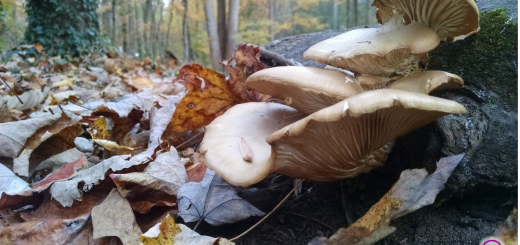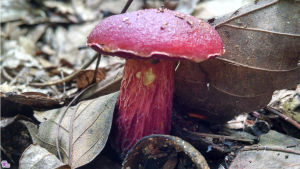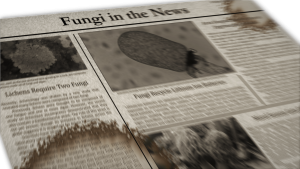#134: Auricularia auricula-judae, the Jelly Ear Mushroom
This distinctive, ear-shaped mushroom is brown in color and gelatinous in texture. Auricularia auricula-judae is a common find in North America and Europe and has a close relative in Asia. As a result, the fungus has accumulated a variety of common names. The two most commonly used names in English are “Jelly Ear,” “Wood Ear,” and “Tree Ear.” Other popular names for this mushroom include “Judas’ Ear” or “Jew’s Ear.” In most European countries, the regional common name translates to “Judas’” Indeed, the species name for this mushroom translates to “Ear of Judas.” English translations of Asian names for this mushroom include: “Wood Ear Mushroom” and “Cloud Ear Mushroom.”
So what’s up with this mushroom’s name? Early on, (in Europe) this mushroom was linked with the Christian story of Judas’ death. The New Testament reports that Judas (who was a disciple of Jesus but eventually betrayed Jesus) ended his life by hanging himself from a tree. Supposedly, the tree was an elder tree. A. auricula-judae is frequently found on elder wood, so the ear-shaped growths were presumed to be manifestations of the curse left on the tree due to Judas’ actions. This led to the common name Judas’ Ear. Later, that name was shortened to Jew’s Ear (Judas was a Jew, so this is not too much of a leap). Unfortunately, this name can be taken to suggest that the Jews were responsible for Jesus’ death (for all the biblical literalists out there, it was technically the Romans who killed Jesus). This can reinforce negative stereotypes toward Jewish people, so most people recommend against using the name “Jew’s Ear.” Some authors (for example, Michael Kuo from MushroomExpert.com) prefer to use the scientific name Auricularia auricula for this mushroom, since that gets science away from the controversial name. However, the naming rules for fungi mean that this name is unlikely to be officially accepted. Personally, I prefer using the names Auricularia auricula and Jelly Ear.
The Jelly Ear is distinguished by its ear-like shape, gelatinous texture, and brown color. Its mushrooms are small to medium-sized (2-15cm or 1-6in across) and semicircular to kidney-shaped, though occasionally become completely circular. The mushrooms are attached at the center and are radially wrinkled or irregularly folded. As a result, the mushrooms often end up looking like ears. Usually, the ears are oriented parallel to the ground and often hang down at the edges. The top of the ear is finely hairy, which gives the surface a whitish sheen that is more noticeable when the mushroom is dried out. Spores are released from the lower surface and leave a white spore print. Jelly fungi dry out and rehydrate easily, which helps them remain viable during dry spells. When dried out, the mushrooms are small, tough, and dark brown to blackish. Although they retain most of their shape when dried out, they may look unrecognizable as the Jelly Ear at first.
A. auricula-judae can be found in North America, Europe, Asia, and Australia. In these areas, it is a common find on dead hardwood (especially elder) or conifer logs, where it can be seen throughout the year. The fungus decomposes dead wood, but this wood may still be attached to a living tree. A. auricula-judae is not parasitic, so it does not attack living tissues even when growing on living trees. There are a few look-alikes to this mushroom, so you should always consult a local field guide for accurate identification when collecting for the table. I am unaware of any poisonous look-alikes to the Jelly Ear.
Despite its unusual texture, the Jelly Ear can be used in cooking. In fact, it is frequently used in Asian cooking (the species cultivated in China is actually A. polytricha, a close relative). Although it has no taste on its own, it does provide an interesting texture to dishes. Additionally, the mushrooms absorb the flavors of the dish. The Jelly Ear is often used in soups to make the texture more interesting.
A. auricula-judae has also been used in herbal medicine. In Europe, the mushroom was used to treat throat and eye ailments. In China, it was used to treat hemorrhoids, hemoptysis, angina, and diarrhea as well as to provide strength and boost the immune system. Modern medicine has found that the mushroom can prevent blood clotting (there have even been some reports of internal bleeding in sensitive people after eating too much of this mushroom), prevent heart attacks, prevent strokes, and lower blood cholesterol. Some studies claim that it can treat cancer, treat diabetes, and reverse the ageing process. Apparently, A. auricula-judae negatively impacts fertility, so people who are trying to conceive and women who are pregnant or lactating may want to avoid this mushroom.
See Further:
http://botit.botany.wisc.edu/toms_fungi/apr2004.html
http://www.mushroomexpert.com/auricularia_auricula.html
http://www.first-nature.com/fungi/auricularia-auricula-judae.php
http://www.rogersmushrooms.com/gallery/DisplayBlock~bid~5580.asp








![#011: Characteristics of Kingdom Fungi [Archived]](https://www.fungusfactfriday.com/wp-content/themes/hueman/assets/front/img/thumb-small-empty.png)



3 Responses
[…] jelly fungi are found in the order Auriculariales. These include the Judas’ Ear or Wood Ear, Auricularia auricula. This edible mushroom is used in Asian cuisine and is commercially available. The Wood Ear is […]
[…] edible jelly fungi, so I don’t bother collecting it. Like the Jelly Ear (Auricularia auricula, FFF#134) and the Snow Fungus (Tremella fuciformis, FFF#023), Witch’s Butter would be eaten for its […]
[…] my area, Ductifera pululahuana is the second most common jelly fungus (after the Wood Ear, FFF#134) that appears in late spring or early summer. It is a strikingly white mushroom that grows in […]